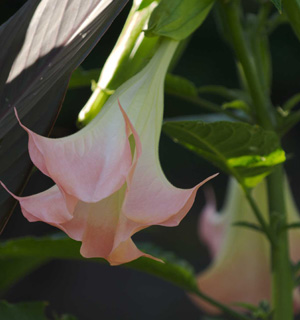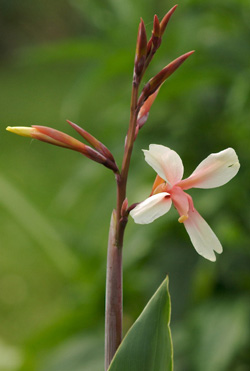





As a founding employee of Gardener's Supply, I wore many different hats over the years. Currently, I have my own company called Johnnie Brook Creative. The gardens around my home in Richmond, VT, include a large vegetable garden, seasonal greenhouse, cutting garden, perennial gardens, rock garden, shade garden, berry plantings, lots of container plants and a meadow garden. There's no place I'd rather be than in the garden.

With blooms like this, it’s easy to make time and space for saving a brugmansia.
Bougainvillea, jasmine, mandevilla, banana, agapanthus and taro. Nowadays, you can find most of these and many other tropical beauties at local garden centers. Gardeners in nearly every growing are enjoying the thrill of growing heat-loving plants in their gardens and on their decks or patios. What a wonderful new palette of plants to get to know and love!
But what happens to these cold-sensitive plants when fall comes around? The easiest solution is to bid a sad adieu, let the frost claim its victims, and send the blackened plants to the compost pile. But most gardeners are too tender-hearted—and thrifty—to let a good plant go to waste. If you grew a few tropical plants in your garden this summer and want to try your hand at keeping them alive indoors until next spring, you have three options:
1. Keep the plant in active growth in a warm, sunny place (like a sunroom or heated greenhouse).
2. Take cuttings and allow the "mother" plant to die. Root the cuttings and pot them up so you have new plants in the spring.
3. Allow the plant to go dormant and keep it in a cool, dark place until spring.
If you have a sunny window where the air temperature stays about 60-70 degrees, you can keep most tropicals growing and possibly even blooming right through the winter. Bougainvillea, jasmine, citrus, hibiscus and geraniums are some of the plants that will be happy in this situation, as long as they get plenty of light, and nighttime temperatures don't drop below 40 degrees. Plants that are relatively small will be happy to spend the winter under a grow light. Set a timer to ensure they get about 12 hours of light each day.
Make sure to bring these plants into your house or sunroom before the weather turns cold and definitely before frost threatens. Expect that the plants will drop some leaves the first few months as they adjust to living indoors. Water as needed, but keep the soil on the dry side. Avoid crowding, because good air circulation will help deter pest and disease problems (try running a small oscillating fan for several hours each day). If possible, keep the humidity level between 30 and 45 percent by misting or placing a pan of water among the plants. In cold climates, keep the humidity below 30 percent to avoid condensation on your windows.
Keep in mind that the ideal winter environment for most of these tropical plants would be approximately 50 degrees at night and 65 degrees during the day. Warmer air temperatures can lead to leggy growth and bug problems. Whiteflies, spider mites and scale are the most common indoor pests. Check your plants weekly. If you stay on top of the situation, pests can usually be controlled quite easily with insecticidal soap. For serious infestations, dunk the foliage in a dishpan filled with water and a teaspoon of liquid dishwashing detergent. You can also stick large plants right in the shower. Let the foliage dry and then douse with insecticidal soap.
Tropical plants that go through the winter in fairly active growth usually benefit from being pruned at least once or twice. This will re-balance the foliage to root mass ratio and will also give you the opportunity to root some new cuttings. Coleus, plectranthus and geraniums respond well to this treatment. When spring comes, repot the plants and start fertilizing. Plant Health Care is a good, organic-based water-soluble fertilizer.
2. Taking CuttingsHerbaceous, soft-stemmed tropicals such as plectranthus, coleus and geraniums, can be difficult to overwinter. A good option is to take cuttings in the fall and let the "mother" plant die. Root the cuttings in water on a windowsill. Be sure to root succulent, young stems—not stems that have become tough or woody. Put only the stem—no leaves—in the water. Once roots have developed, plant each cuttings in a 3- or 4-inch pot and keep them on a windowsill or under lights. Fertilize regularly. You'll have a whole batch of new plants for your spring garden, and will be a popular guest at next year's plant swaps!
3. Managing Winter Dormancy
Cannas are especially easy to overwinter. Just dig up the tubers and store them in pots with soil.
Some tropicals do best with—or may even require—a winter rest. How you care for these plants over the winter depends on the kind of space you have available, and whether the plants are soft-stemmed, woody, or bulb-like. Tropical plants that grow from bulbs or tubers, such as elephant ears, caladium, sweet potato vine and canna lily, should get nipped by frost before they're brought indoors. This sends the plant a clear message that the end of the season has come. At this point you can do one of two things. You can leave the plants right in their pots over the winter, keeping the soil barely moist, and store the whole pot in a cool, dark place. Or, you can trim off the stems, dig up the bulbs, label them, wrap individually in slightly moistened newspaper or peat moss, place them in a black plastic garbage bag and store a cool, dark place. In either case, it is important that air temperatures remain at about 40 to 50 degrees F. Check the bulbs monthly to make sure they are still firm and solid. If they are drying out, mist the storage material around them with a little water. When spring arrives, repot the bulbs, begin fertilizing regularly, and put the plant in a sunny window.
Woody-stemmed tropicals, such as jasmine, brugmansia, tibouchina and bananas, should be brought indoors before the first frost. Let the plants rest in a cool place (40 to 50 degrees F) with little or no light—they'll get the message that winter has arrived and their leaves will gradually yellow and drop. The plants can then spend the winter in an unheated basement, root cellar, unheated garage, or even a cool closet. Make sure the area is relatively dark (try enclosing the whole pot loosely inside a heavy black trash bag) and that the air temperature stays above freezing. In most cases, woody-stemmed tropicals should not be cut back until early spring (unless you can't fit them into the house!). Water the plants sparingly throughout the winter, checking monthly to see that the soil is barely moist. When early spring arrives, revive the plants by repotting them in fresh soil. Water thoroughly and provide a weak dose of liquid fertilizer. Expose the plants to bright, filtered light, gradually acclimating them to full sun. Try to give them about a month of indoor (or greenhouse) growing time before moving them outdoors.
When it comes to reintroducing heat-loving tropicals to the outdoors, always do it slowly. Shield them from direct sunlight and wind for at least a week or two. If the plants are acclimated slowly, they'll slide right into active growth. Too much early spring stress will stunt the plant's growth — or even kill it.
The truth is, overwintering tropical plants involves a bit of trial and error. A technique that works well for one type of plant or in one particular winter environment may not be ideal for another. Be prepared to lose a few plants. See the box called Overwintering Techniques, above, for some general recommendations to get you started. For specific information about growing and overwintering more than 100 tropical plants, consider investing in the book Hot Plants for Cool Climates by Susan A. Roth and Dennis Schrader. (Houghton Mifflin 2000).
Copyright © www.100flowers.win Botanic Garden All Rights Reserved